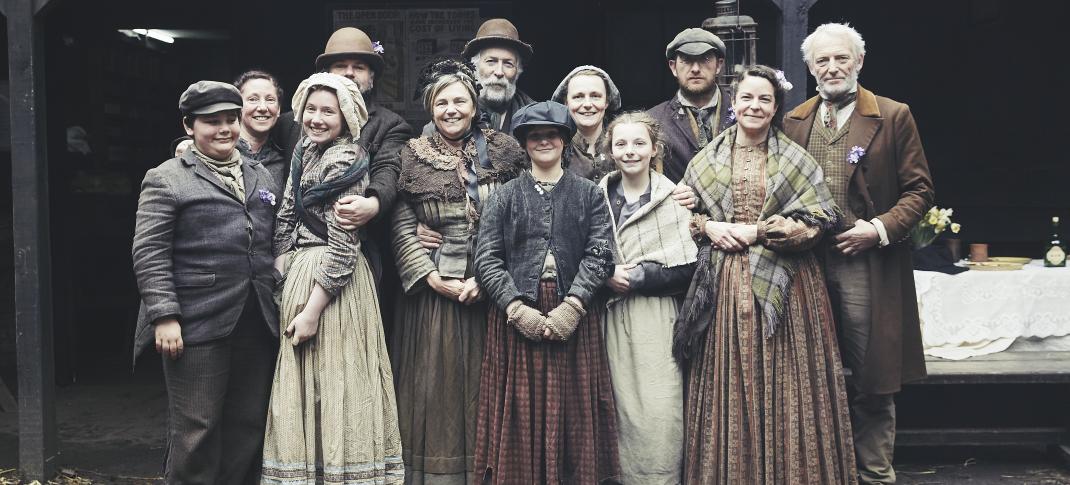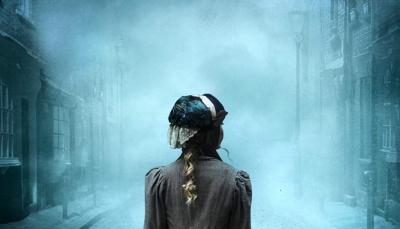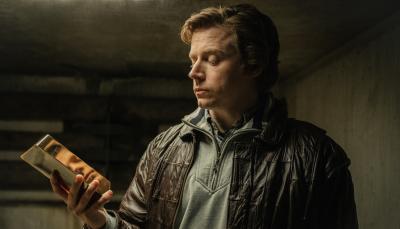‘Victorian Slum House’: Reality Programming Without the Guilt

Joe Sarah 2016
I realize it’s a bit late in the game to be mentioning this, but Tuesday night on PBS has become a must-see TV night for me recently. My enthusiasm is all due to a new educational reality mini-series set in Victorian era London, called Victorian Slum House. You may recall similar programs such as The 1900 House, The 1940’s House, and Regency House Party which aired on PBS channels in past years.
Now the same production company has recruited several ordinary 21st century families and other individuals to experience what life was like for London’s urban poor. Housed in a historically recreated East London tenement, the volunteers attempt to survive tough living and working conditions without any safety nets, similar to what their ancestors endured during the Victorian period. Each episode highlights the social issues and harsh economic realities of a distinct decade beginning in 1860 and ending with 1900.
Many sociological tidbits are disseminated by series presenter Michael Mosely; however, it is the day to day adversities faced by the participants that engage viewers in this living history lesson. Let’s meet the brave residents of the Victorian Slum House:
The Potter/Oldfield Family
This multigenerational family is made up of Graham and Heather Potter, their daughter Allison Oldfield and her two daughters Olivia and Heather (the younger). Graham is a retired carpet salesman and so they have been cast as an unskilled worker family who must share one room.
On his first day out in the unpredictable job market, Graham finds work at a bell foundry. After a very long shift of hard physical labor, he injures his back. The family must band together to find alternate ways to make the rent and buy food. From assembling matchboxes and artificial flower, selling street food like jellied eels and sheep’s trotters, and working as laundry assistants, it takes relentless effort from all the family to make ends meet.
The Howarth Family
Russell and his wife Mandy are joined by their children Rebecca and James. Mr. Howarth’s real life occupation as a tailor put his family in a slightly better position than some of the other participants. The skills he possesses were also utilized in the Victorian era. As the decades pass, the Howarths advance from a hand stitching, rag trade operation in their small flat to running a sweater’s den of sorts with sewing machines and employees of their own to finally achieving the dream of operating their own tailor shop, Howarth & Son Ltd.
That being said, they struggled financially in the early decades. Their rent increased with each professional advance they made. They worked inhuman hours to get the orders done on time and had to weather a strike when their work crew walked out due to low pay and strict penalties they imposed for rule breaking.
The Birds
Adrian and Wiebke Bird have been chosen to be the shopkeepers of the slum and their main job is to keep the people of the tenement fed. While their living quarters are luxurious compared to some of their neighbors, the couple’s position involves an added risk to their livelihood. When customers come to their store for food, the Birds must determine how much, if any, credit they will extend to them on “the tick”. If they allow their empathy and generosity to influence their judgement too much and someone can’t pay them back, they could end up homeless as well as leaving the community without a reliable source of food. Their fortunes are also tied to food prices and during a multi-decade period of economic downturn, their profit margins were very small indeed.
Andy Gardiner
Andy is the designated rent collector for the slum’s absentee landlord. For this troubles, he gets a room rent-free. He also runs the doss house which provides very minimal comfort lodging for those who can’t afford a room of their own. If no one checks into his accommodations, Andy doesn’t eat. Which may explain why he was willing to take tourists around to gawp at his neighbors for the entrance fee of a few pennies. In fact when his doss house is shut down for health and safety violations, Andy resorts to making fraudulent creams and balms to sell to unsuspecting customers.
Though Mr. Gardiner doesn’t have a family to support in the slum, he is an amputee and this makes it difficult to take on some other kinds of work that might supplement his meager income. While not required by the program’s producers, Andy wanted to swap his high-tech prosthetic leg (which is a necessity for his 21st century career as a professional golfer) for an approximate version of a Victorian peg leg. Fortunately for Andy it was fitted to his stump and made of fiberglass instead of wood.
Other people come and go during this experiment. Single mother Shazeda and her young twins did a midnight flit after being unable to pay their rent or the money on their tick from the Bird’s store. Irish siblings John and Maria also inhabited the slum for a time. Being young, strong and motivated they were able accumulate enough money to leave for greener pastures whereas others found themselves stuck in the cycle of abject poverty.
If you haven’t seen this fascinating program on the plight and transformation of the lower classes in Victorian England, one more episode remains to be aired on Tuesday, May 30 at 8:00 pm ET. Check local listings for times in your area of course. The previous four installments can be streamed online.
If you have been watching, how do you rate it so far? Was Victorian poverty even worse than Dickens lead us to believe? How closely do you think the residents had to adhere to Victorian conditions? Do you have a favorite slum dweller? Would you ever subject yourself or your family to such an experiment? Share your insights and opinions in the comments below!



